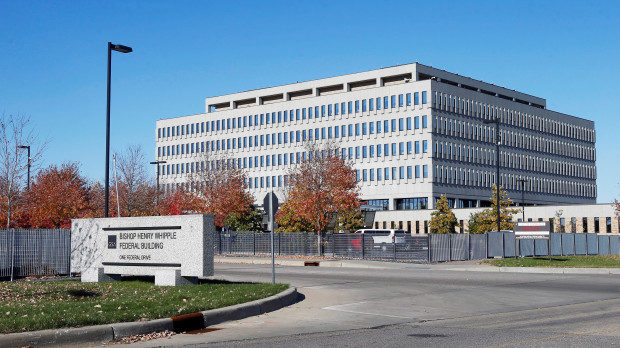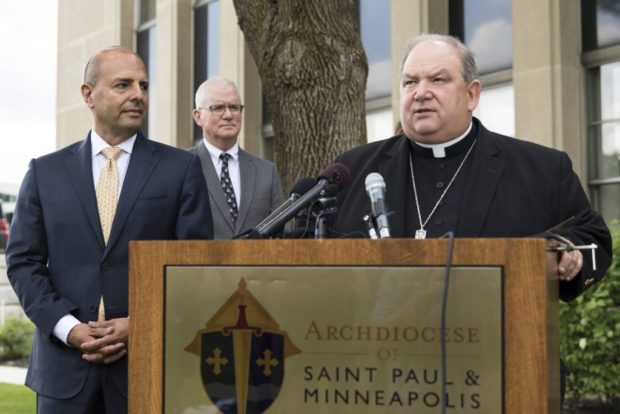Minnesota Clergy: ICE Critics Want Bishop’s Name Off Building
Clergy and immigration activists in Minnesota are trying to remove the name of a revered bishop from a federal building where hundreds of deportation orders are issued every year, calling the Trump administration’s immigration crackdown an affront to his memory.
The Bishop Henry Whipple Federal Building at Fort Snelling houses the Minneapolis-area offices of Immigration and Customs Enforcement and the Department of Homeland Security.
Learn more about #humantrafficking by watching this video clip. Full video can be found: https://t.co/ielRqnqj1p pic.twitter.com/xyVhm89ldM
— DHS Blue Campaign (@DHSBlueCampaign) October 28, 2019
It’s named for the first Episcopal bishop of Minnesota, who persuaded President Abraham Lincoln to pardon most of the 303 Dakota Indians sentenced to death after the U.S.-Dakota War of 1862, though 38 were still hanged in the largest mass execution in U.S. history.
Now the Episcopal Church in Minnesota, the Minnesota Council of Churches and others want Whipple’s name taken off the building — or the eviction of ICE and its immigration courts. They’re planning a vigil and news conference outside it Tuesday to launch the “What Would Whipple Do?” campaign. They’ll also call on the Legislature to declare Minnesota a sanctuary state.
“We believe that Bishop Whipple is turning over in his grave,” said Daniel Romero, a volunteer leader of the Interfaith Coalition on Immigration and the ministerial candidate with the United Church of Christ who’s been a lead organizer. “Bishop Whipple himself would never have endorsed his name going on a building where so much fear and terror is manifested.”
It’s not unheard of for names of historical figures to be taken off buildings and other landmarks or for monuments to be removed when history judges the person to be less than honorable.
But removing the name of a venerated figure from a building because of what goes on inside puts a new twist on the bitter U.S. immigration debate.
Whipple emerged from the aftermath of the U.S.-Dakota war as a leading advocate for justice for Native Americans. So it’s “intolerable” that a building named for him is now a place where immigrants arrested in five states are brought to court and eventually deported, said another organizer, the Rev. Devon Anderson, rector of Trinity Episcopal Church in Excelsior.
The current Episcopal bishop of Minnesota, the Rt. Rev. Brian Prior said he’s concerned about how immigrants are being marginalized “in a building under the name of our patriarch, who was so clear that this is not who we are.”
The Associated Press left messages for three potential Whipple descendants without any immediate response. Diocesan spokeswoman Kelsey Schuster said she reached out to one Whipple descendant who wasn’t interested in commenting.
“I think it’s an opportunity to create greater awareness, said the Rev. Curtiss DeYoung, CEO of the Minnesota Council of Churches, “We often hear what is happening at the border but are unaware that similar things are happening right here.”
Romero said their research found that Emily Murphy, the administrator of the General Services Administration, has the authority to change the name. But GSA spokeswoman Pamela Pennington said the agency’s policy is to defer to Congress on the naming of federal buildings.
A regional spokeswoman for ICE and Homeland Security deferred a request for comment to the GSA since it oversees the building.
Whipple’s name was added to the building, which opened in 1969, at the initiative of then-Sen. Walter Mondale, of Minnesota. The Democrat has met with Romero and other organizers and recently spoke with Murphy.
“I was asking if she knew any way we could resolve this peaceably,” Mondale said.
“She said, unfortunately, their agency has taken the position over the years that if the decision has been made by Congress, there’s a heavy tendency to defer to it.”
Mondale, an avid student of Minnesota history and a former vice president, said he shares a lot of the organizers’ concerns about the treatment of immigrants and the divisions of families that take place in the building. But he said he’s undecided about removing Whipple’s name from it.
Related Articles
To be sure, there are blemishes on Whipple’s record. While 303 Dakota might have been hung that day if he hadn’t intervened with the president, and he ministered to other Dakota before they were exiled from Minnesota after the conflict, he had paternalistic views about Indians and was a strong supporter of assimilation.
The picture is complex, acknowledged the Rev. Robert Two Bulls, an Oglala Lakota who leads the Department of Indian Work at the Episcopal Diocese of Minnesota. But he said Whipple was ahead of his time — and was vilified for it in a day when many in society wanted the Indians annihilated.
“I think he was a man with a history and a record that deserves to be honored and remembered,” Mondale said. “He was a remarkable human being — and he was ours.”
Inquirer.net will receive a commission on purchases made*



